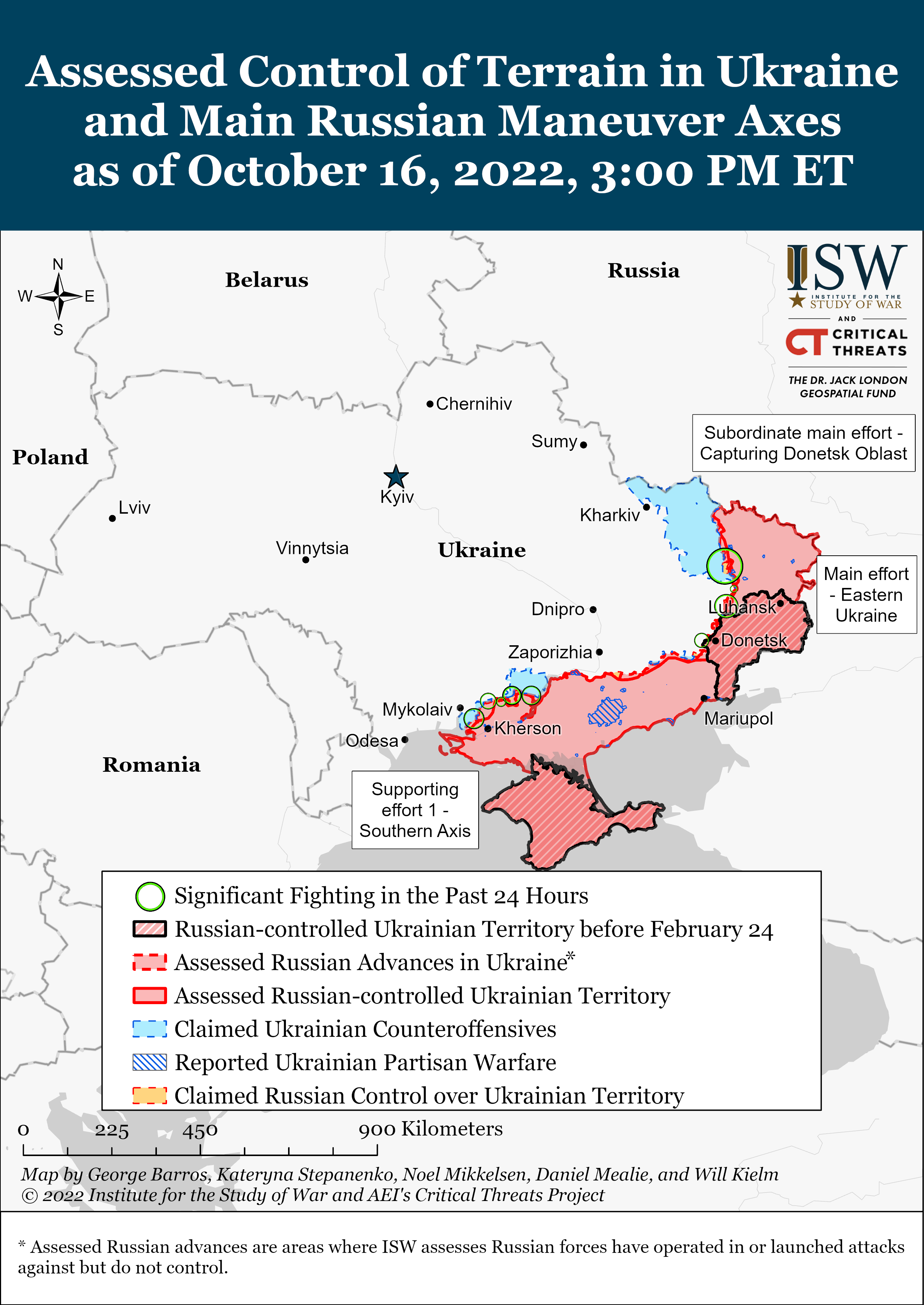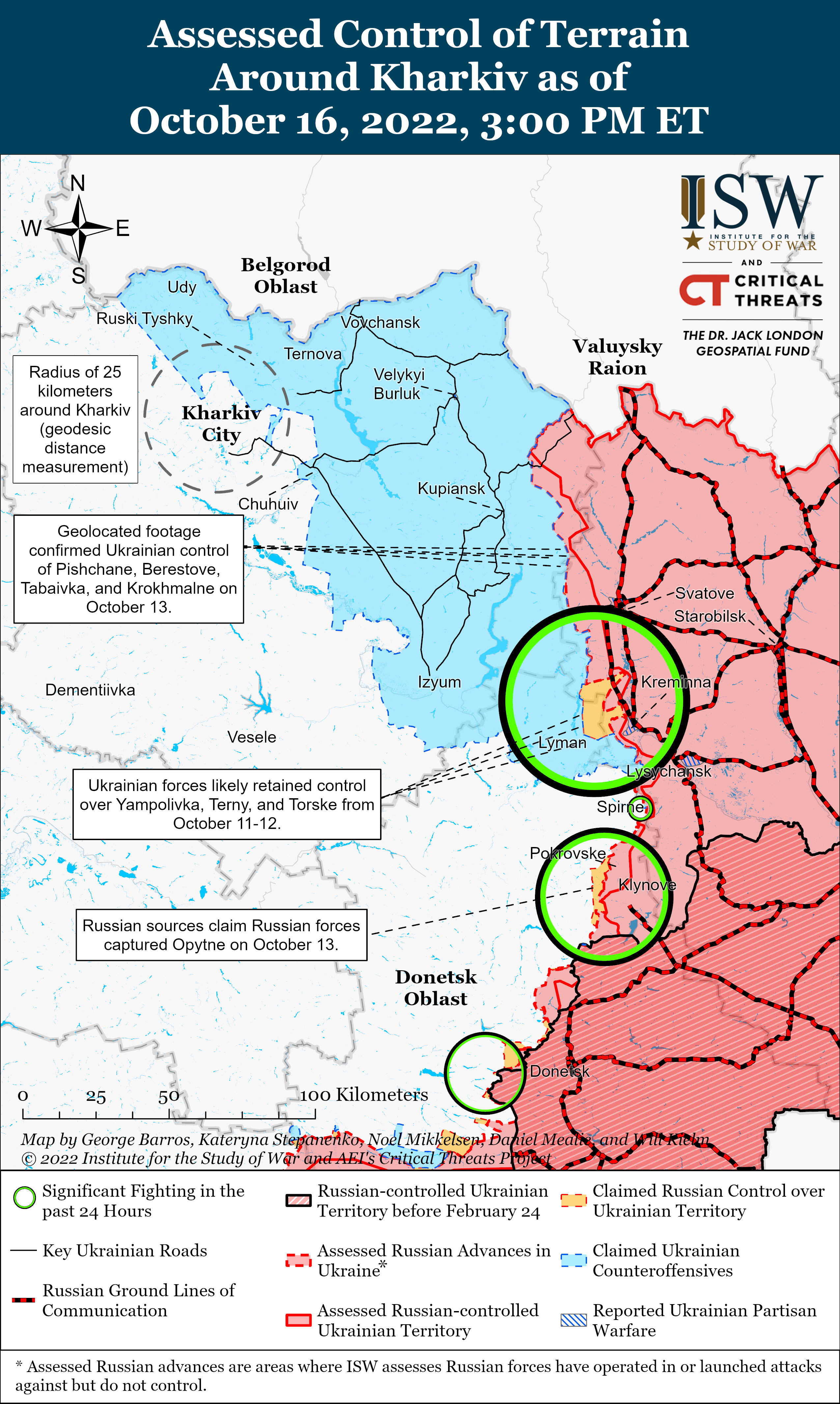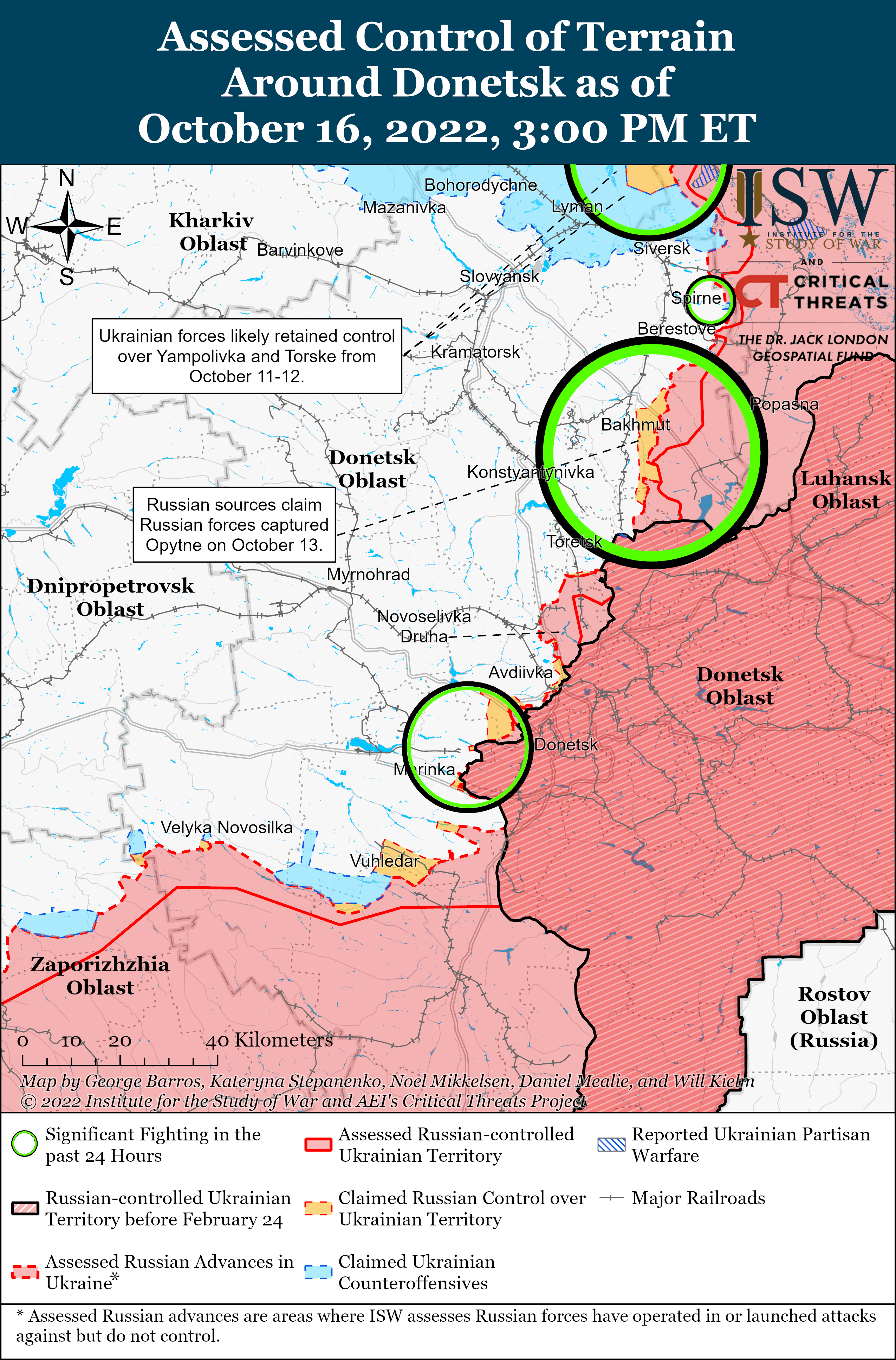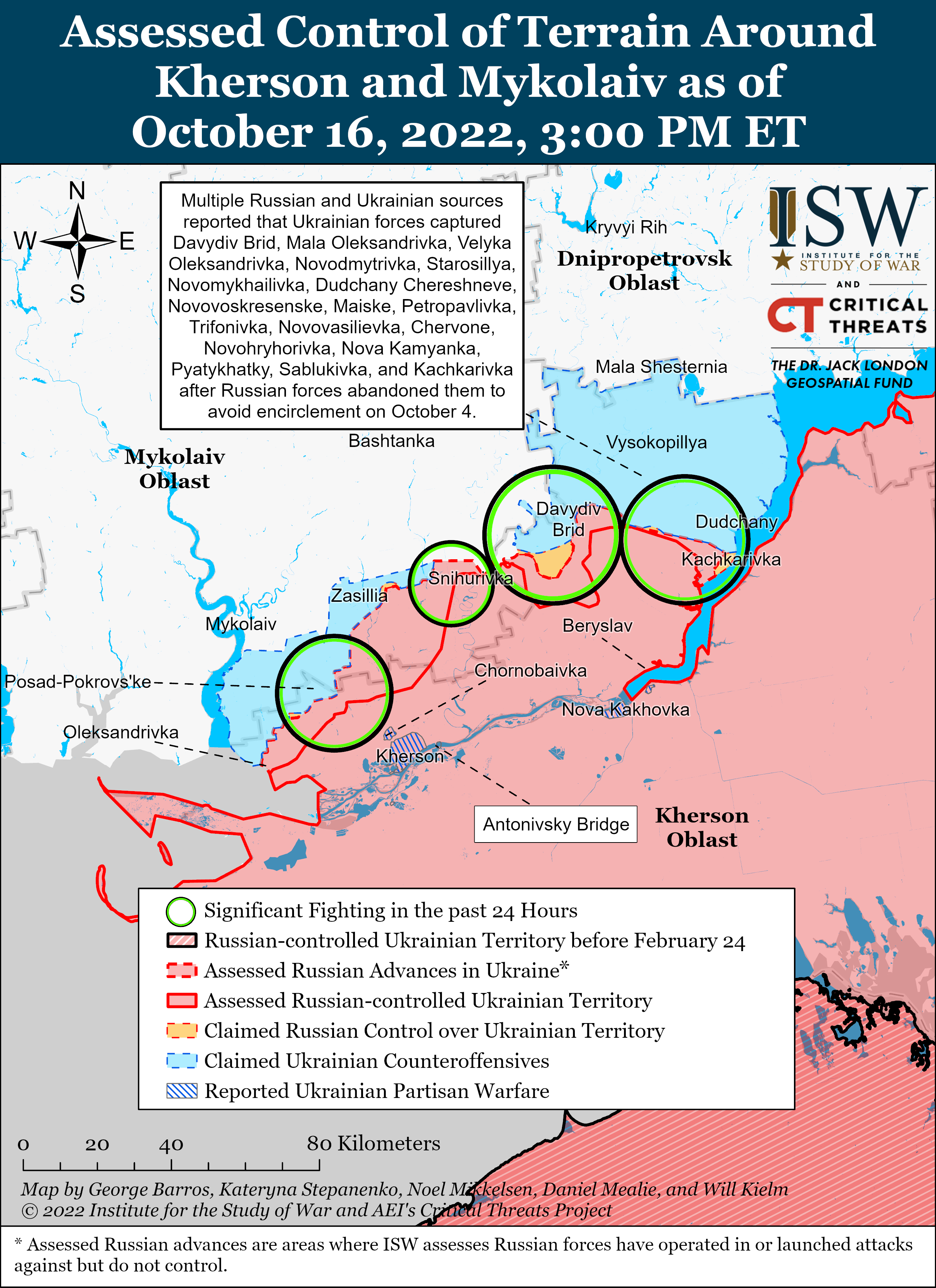Special Edition on Key Terrain in the Russian Invasion of Ukraine
Frederick W. Kagan
October 16, 4:45pm ET
Click here to see ISW’s interactive map of the Russian invasion of Ukraine. This map is updated daily alongside the static maps present in this report.
This campaign assessment special edition focuses on the specific parts of Ukrainian territory currently under Russian occupation that are important for the long-term viability of an independent Ukraine. Ukrainian forces are currently conducting a counteroffensive push in Kherson Oblast as of October 16. We will update our maps after information about the new front lines unambiguously enters the open-source environment.
Ukraine must regain certain specific areas currently under Russian occupation to ensure its long-term security and economic viability. Ukraine’s ability to defend itself against a future Russian attack requires liberating most of Kherson and Zaporizhia Oblasts. Ukraine’s economic health requires liberating the rest of Zaporhizia Oblast and much of Donetsk and Luhansk Oblasts, including at least some territory Russia seized in 2014. Ukraine’s security would be materially enhanced by liberating Crimea, which would also benefit NATO’s ability to secure its southeastern flank.
Ukraine has every right to fight to liberate all the territory Russia has illegally seized, particularly in light of the continued atrocities and ethnic cleansing Russia is perpetrating in the areas it occupies. Kyiv’s insistence on regaining control of Ukrainian territory to the internationally-recognized borders is not an absolutist or extremist demand—it is the normal position of a state defending itself against an unprovoked attack as part of a war of conquest. It is also the default position of the international community under international law, as it should be. Nothing in the following discussion should be construed as supporting any attempt to encourage, let alone coerce, Ukraine to abandon either its claims or its efforts to free all its land and people.
However, Ukraine also requires the liberation of the areas mentioned above for purely strategic military and economic reasons. ISW continues to assess that Putin’s intentions toward Ukraine are unlikely to change whether or not a ceasefire or some other settlement occurs. The Kremlin would use any suspension of hostilities to consolidate its gains and freeze the frontline in the best configuration Putin can get to prepare for future coercion and aggression against Ukraine. Those seeking enduring peace in Ukraine must resist the temptation to freeze the lines of combat short of Ukraine’s international borders in ways that set conditions for renewed conflict on Russia’s terms. The purpose of this brief essay is to consider why specific parts of Ukrainian territory still under Russian occupation are so important for the long-term viability of an independent Ukraine that is not a financial ward of the international community and can effectively defend itself against a renewed Russian invasion.
The Dnipro River is a formidable obstacle for its entire course in Ukraine. Any military would struggle to cross it in the face of prepared defenders. The current Russian lodgment on the west bank in Kherson Oblast is therefore a vital piece of terrain. If a ceasefire or any sort of agreement suspends fighting with the Russians still in possession of that lodgment, the prospects for a renewed Russian offensive in southern Ukraine would be vastly improved. If Ukraine regains control of the entire west bank of the river, on the other hand, the Russians would likely find ground attacks against southwestern Ukraine extraordinarily difficult. The long-term defensibility of Mykolayiv, Odesa, and the entire Ukrainian Black Sea coast thus rests in no small part on the liberation of western Kherson.
Parts of Kherson Oblast on the east bank of the Dnipro are also strategically critical, however. The oblast follows the line of the river to its mouth and then juts out into the Black Sea, coming to within about 40 miles of Odesa. The tip of the Kinburn Spit, the northwesternmost point of this part of Kherson Oblast, is less than 2.5 miles from the city of Ochakiv on the west bank of the Dnipro. Russian military positions in these areas allow Russian forces to bring artillery, drone, and missile fire against much of the Ukrainian Black Sea coast from many short-range systems without having to use expensive longer-range capabilities that will always be in shorter supply. These short distances also make the prospect of amphibious operations far more plausible and easier to support by fire than if the Russians had to conduct them from bases in Crimea. Ukraine’s hold on its entire western Black Sea coast will remain tenuous as long as Russia holds territory in southwestern Kherson much further north than the 2014 lines.
Tracing defensible lines requires constantly referring to the roughly 25-kilometer maximum effective range of the 152mm artillery system. All modern armies have ground-based systems with much longer ranges, to be sure. But 152mm guns are relatively easy and inexpensive to mass produce, as are the rounds they fire. They are also effectively impossible to defend against when used at scale. Systems exist that can shoot down individual artillery rounds (as well as missiles and drones), but not that can shoot down thousands of them at a time. The Russians showed how effective massed bombardments by such weapons can be in their seizures of Severodonetsk and Lysychansk, where they pounded Ukrainian troops with artillery and enabled relatively weak Russian ground forces to advance. Planners must assume that Ukrainian positions within 25 kilometers of Russian lines may be subjected to massive artillery barrages from the outset of a renewal of hostilities.
Sound military doctrine also teaches that one does not attempt to defend a position by standing on it—reliable defenses must be established well forward of the points or lines that must be held. The Dnipro River should not be Ukraine’s first line of defense, but rather its last. Contested river crossings are very difficult but can be made easier if the attacker can make all preparations right at the river, including establishing protected artillery positions, pre-positioning bridging equipment, amassing necessary supplies, and generally laying in all the infrastructure needed to get across a wide river while the defenders fight back. The river is most reliable as a defense if the Russians must first advance to it and then prepare to cross it while Ukrainian defenders disrupt their efforts.
Ukraine must therefore be able to establish and hold positions on the eastern bank of the river. Those positions cannot be in a narrow strip along the river, however. They must be far enough away from the river that a concerted Russian attack cannot easily throw them back against the river itself—a potentially disastrous position for the defender. They must also be far enough east to keep the Russians out of artillery range (about 25 kilometers) of the west bank to prevent the Russians from bombarding Ukrainian defenders on that bank from the outset of a renewed invasion. The 2014 line of contact north of Crimea was close to the limit of how far Russian forces can be allowed to hold ground in the south without beginning to put the Ukrainian defense of the Dnipro and what lies behind it at risk. The distance from the northwesternmost part of those lines to the river at closest approach is about 70 kilometers, which is far enough to allow Ukraine to establish front-line defenses at the line of contact and then a main defensive area out of tube artillery (152mm) range, from which Ukrainian defenders could retreat some distance if necessary while still keeping the Russians out of artillery range of the river and avoiding finding themselves pressed right up against the river.
Consideration of key terrain in eastern Kherson and western Zaporizhia Oblasts must integrate security and economic concerns because of the location of the Zaporizhzhia Nuclear Power Plant (ZNPP) at Enerhodar. The plant provided a significant proportion of Ukraine’s electricity before the 2022 invasion, and its loss would require considerable investment to replace the generating capacity and possibly redesign elements of Ukraine’s electrical grid. The liberation of Enerhodar in a way that allows the plant to come back online is therefore central to containing the costs in time and money of the restoration of Ukraine’s economy, which is in turn central to allowing Ukraine to avoid becoming an expensive ward of the international community.
Russia’s demonstrated irresponsibility toward nuclear facilities in Ukraine also makes restoring the ZNPP to Ukrainian control essential from a security perspective. Russian forces damaged the inactive Chernobyl facilities, kicking up radioactive dust and irradiating themselves in the process. Russian false-flag operations and the use of the ZNPP grounds as a base for conventional military operations show a similarly cavalier attitude toward the dangers of bringing war to a massive nuclear power plant. Allowing Moscow to retain control of the ZNPP puts Ukraine and all Black Sea states at permanent risk of the downstream consequences of Russia’s willingness to play with nuclear fire. The Russians must therefore also be kept out of artillery range of Enerhodar. Taking an approach to calculating required positions similar to the one used above would bring the line required to allow Ukrainian forces to reliably defend the ZNPP about 50 kilometers south of Enerhodar in principle. That line would be about 40 kilometers northwest of Melitopol, the next major geographical feature to consider.
Melitopol is a critical junction of roads that run from the Dnipro around the Nova Kakhovka Dam to the Sea of Azov coast and ultimately Mariupol on the one hand and that run from Crimea north to the city of Zaporizhia on the other. If the Russians retain control of Melitopol and the roads running south and east of it, they can and likely will turn it into a major militarized base from which to launch mechanized attacks across the largely flat steppe land to its north and west. Such a base, which could come to be similar to Belgorod, Russia, in the extent of military facilities and capabilities it houses, would be a permanent threat to the ZNPP, Ukrainian positions on the east bank of the Dnipro River, and the major cities of Zaporizhia and Dnipropetrovsk as well. If Ukraine regains control of Melitopol, on the other hand, the Russians would be confined to Crimea and the narrow and vulnerable road and rail connections across the Perekop Isthmus that separates Crimea from the mainland. Defense against such an attack is far easier than would be a defense against an attack that could use Melitopol as a well-stocked and fully prepared forward base.
Further east the weight of consideration becomes more economic. The Donbas—the area of Donetsk and Luhansk Oblasts divided by the line of control since 2014—had been a single integrated economic unit for centuries. Its mineral deposits were extracted and sent by rail to the port of Mariupol, on the one hand, and to Ukrainian industries in the west on the other. The 2014 Russian seizure of large parts of Donetsk Oblast disrupted this economic activity to Ukraine’s detriment. Permanently removing the entire Donbas would do far more serious economic damage to Ukraine. The reconstruction of a viable Ukrainian economy that does not require large amounts of long-term international financial assistance requires restoring the Donbas economic region to Kyiv’s control.
The military requirement for that restoration includes the Ukrainian liberation of Mariupol and the road and rail networks north via Volnovakha toward Donetsk City and to the west toward Melitopol and Zaporizhia City. Establishing secure Ukrainian control over Mariupol requires liberating at least some of the land the Russians had seized in 2014. The line of control resulting from that invasion was too close to the city to allow its defenders to avoid encirclement in the face of determined attacks. The same calculations used above regarding 152mm artillery ranges would argue that Ukraine must actually recapture all its land to the internationally recognized border, in fact.
Similar economic arguments hold for the historically industrial cities of Donetsk, Severodonetsk, and Luhansk. In the remaining areas of occupied northeastern Ukraine, the balance of concern shifts primarily to the agricultural sector. Grain plays such a critical part in Ukraine’s economy that one could straightforwardly calculate the cost of each lost hectare and consider the requirements to offset that loss over the long term as part of the price of ceding any of this land to Russia.
Northeastern Ukraine does contain some strategically important areas, however. The towns of Svatove, Starobilsk, and Bilovodsk sit on major road junctions, control of which determines in part which bases in Russia proper the Russians can use to support future attacks in Ukraine directly. Russia has major mechanized bases at Valuiki and Boguchar to the northwest and northeast of Luhansk Oblast. Russian forces have been flowing from their bases around Belgorod via Valuiki into northern Luhansk Oblast on the road that runs to Starobilsk and thence westward via Svatove to Kharkiv Oblast. The railway that runs from just north of Luhansk via Starobilsk to the Russian border is particularly important because Russian forces are heavily dependent on rail to move equipment and supplies. The base at Boguchar can also flow forces into Ukraine along a road that runs through Bilovodsk, however. Allowing Russia to retain control of these key junctions and the road and rail networks on which they sit would give Moscow a significant advantage in building up for a renewed invasion from the northeast.
The Crimean Peninsula, finally, is strategically important for NATO as well as Ukraine. Russian possession of the peninsula allows Russia to base anti-air and anti-shipping missiles 325 kilometers further west than it could using only the territory it legally controls. It lets Russia position aircraft in Sevastopol, about 300 kilometers further west than airbases on the territory of the Russian Federation. These differences matter greatly to the scale and scope of the air and missile threat Russia can pose to NATO’s southeastern flank as well as to Russia’s ability to prepare and support future invasions of Ukraine. Of all the Ukrainian lands NATO should desire Ukraine to regain for NATO’s own interests, Crimea should be at the top of the list.
Principled legal, moral, and ethical considerations require supporting Ukraine’s efforts to regain its lost lands and people and should not be dismissed. The aim of this essay has been to show that purely military realities and strategic considerations lead to the same conclusion. If Ukraine is to emerge from this war able to defend itself against a future Russian attack and with a viable economy that does not rely on long-term international financial support, it must liberate almost all its territory.
Key inflections in ongoing military operations on October 16:
- Several Russian sources reported renewed Ukrainian assaults in the Kherson direction and Ukrainian sources reported higher-than-average numbers of daily shelling and missile strikes, but Ukrainian forces are maintaining operational silence about any operations.[1]
- Ukrainian military officials stated on October 16 that Russian forces are falsely claiming to have captured several towns near Bakhmut in the past several days, but Ukrainian forces have held their lines against Russian attacks.[2] Russian forces are likely falsifying claims of advances in the Bakhmut area to portray themselves as making gains in at least one sector amid continuing losses in northeast and southern Ukraine.
- Ukraine’s Main Intelligence Directorate announced a $100,000 bounty for the capture of prominent Russian milblogger and former proxy commander Igor Girkin and confirmed his presence in Ukraine, stating “it is known that one of the most famous Russian terrorists has decided to renew his participation in the war against our state.”[3]
- Russian and Belarusian sources continued to report Russian men and material entering Belarus.[4]
- Ukrainian sources reported Russian occupation officials in Kherson City are stepping up filtration measures against Ukrainian partisans and accelerating efforts to evacuate key materials and personnel from Kherson to Crimea.[5]
- Unknown assailants attacked a military commissariat in the suburbs of Moscow with a Molotov cocktail on October 16.[6]
- Local Russian authorities in Krasnodar Krai reportedly intend to mobilize 1,000 more people by December 2022 and discussed proposals to redirect funding from entertainment events so supply mobilized personnel, seemingly contradicting Putin’s announcement that mobilization will conclude by the end of October 2022.[7]
- Poor medical care in both frontline and rear-area Russian units is exacerbating already dire morale problems.[8]
[1] https://www.facebook.com/watch/?v=470542768378021; https://www.facebook.com/watch/?v=480141197476835; https://www.facebook.com/GeneralStaff.ua/posts/pfbid02QbDVVdQfA7d6m4KBN1TQXBhrYDnLGwiuxHX1BJCQkT1A9tVJuMiqzWh2HoKZkCH2l; https://t.me/Stremousov_Kirill/526; https://t.me/rybar/40265; https://twitter.com/markito0171/status/1581599202714738688.
[2] https://www.unian dot ua/war/bahmut-novini-v-armiji-ukrajini-vkazali-na-brehnyu-zagarbnikiv-shchodo-bojiv-bilya-mista-12013569.html; https://armyinform.com dot ua/2022/10/16/informacziya-rashystiv-pro-zahoplennya-selyshh-poblyzu-bahmuta-ne-vidpovidaye-dijsnosti-sergij-cherevatyj/.
[3] https://gur.gov dot ua/content/hur-harantuie-100000-za-polonenoho-hirkina.html.
[4] https://www.reuters.com/world/europe/belarus-says-host-just-under-9000-russian-troops-2022-10-16/ https://twitter.com/Obronny2/status/1581608684278681603 ; https://twitter.com/Revenka_Valery/status/1581603655098437632; https://t.me/m0sc0wcalling/12995; https://t.me/modmilby/18952.
[5] https://www.facebook.com/GeneralStaff.ua/posts/pfbid021D3Zpu7LfUDk7mqibBDZ1wDfokr75C1ZkfJsyNvuCCDEQUbUpdWS3huzpXtgB9mfl; https://www.facebook.com/sergey.khlan/posts/pfbid0qCV1QHJKcbQztjCjQwb1ct2KsHhwLCaSeEWhuQLKaz7QLweMfBsLv1rbpoSzAGVCl?__cft__[0]=AZXMzt1wGhYXduheagkDR91yFo7pqi-ZaQvoGj9RpC65X9VlwCBSYlqvKAVE4QE7BGOGBdzLgU7avu4LukxKdZS6zx_8jRla2ISZbKZ2W39UC_zKB6SUQ1dbBakmcr4Wy8kJ61kAvvco_LrEHQT-eETy&__tn__=%2CO%2CP-R.
[6] https://t.me/bazabazon/13931.
[7] https://t.me/Taygainfo/35410; https://ria dot ru/20221014/mobilizatsiya-1824084115.html?utm_source=yxnews&utm_medium=desktop.
[8] https://gur.gov dot ua/content/skazhy-spasybo-nashemu-hlavnokomanduiushchemu-kotoryi-nakh-esyl-tut-delov.html; https://www.facebook.com/GeneralStaff.ua/posts/pfbid021D3Zpu7LfUDk7mqibBDZ1wDfokr75C1ZkfJsyNvuCCDEQUbUpdWS3huzpXtgB9mfl.




